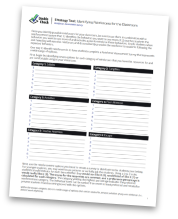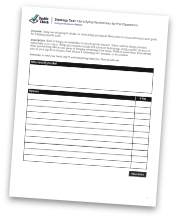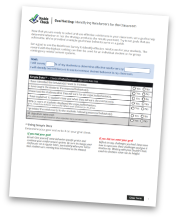Strategy: Identifying Reinforcers for the Classroom
Check-Up Menu > Identifying Reinforcers for the Classroom
Use this strategy to improve these areas:
Overview
Special events, foods, activities, and tangible objects are often used as positive reinforcers to increase the frequency of desired behaviors. Because students differ in their likes and dislikes, what one student finds rewarding may not appeal to another student. Teachers cannot simply choose a reinforcer and assume it will be effective for a particular group or individual. The true test of a reinforcer is its ability to strengthen the behavior that occurs before it is given. Therefore, it is important to identify rewards that students are interested in earning.
Purpose
When students are provided with a positive reinforcer (e.g., computer time, fun activity, sticker) following a behavior, they are more likely to repeat that behavior in the future. Thus, effective reinforcers can encourage students’ use of successful classroom behaviors. However, to be effective, rewards need to be reinforcing. When reinforcers do not result in the expected or desired outcomes, it may be that the selected reward is not sufficiently reinforcing to the students. Therefore, it is important to identify rewards that have a high probability of being positive reinforcers.
How Identifying Reinforcers for the Classroom Connects to CARES
Reinforcers must be individualized and tailored to your particular classroom and school community if they are going to motivate behaviors. Authentic relationships with students and sensitivity to students’ cultures will ensure that you are choosing reinforcers that will work in your classroom. Furthermore, using a variety of reinforcements that you’ve gotten your students’ input about will relay the message to them that you are truly listening to them and that you value them.
Some key elements to choosing effective reinforcers:
1) The reinforcer is age appropriate.
2) The reinforcer can be delivered as soon as possible following the desired behavior; effectiveness is diminished when a student must wait to receive it.
3) The reinforcer is delivered with enthusiasm to emphasize the importance of what the student has done.
4) The reinforcer can be delivered as frequently as necessary to establish a new skill.
5) The reinforcer is of value to the students.
How To
How to Identify Reinforcers for the Classroom
Surprisingly, a self-report survey in which students are asked to list potential reinforcers is the least effective way to accurately identify reinforcers. An evidence-based strategy that leads to more accurate options is a Reinforcer Survey, which provides predetermined options that students can select based on their preferences. A survey can also be created and voted on by the whole class.
There are five categories of reinforcers to consider:
- Social reinforcers are potentially effective for all students at any age. Social reinforcers can include teacher and/or peer attention.
- Activity reinforcers work well for students who are self-directed and can accept a delay between the behavior and the reinforcement. Any social, work, or play activities that students engage in voluntarily are potential reinforcers. Extra recess time, leading the school pledge, playing a game, five minutes of talk time, listening to music, and computer time are all activity reinforcers that are available at little or no cost.
- Tangible reinforcers (e.g., comic books, notebooks, stickers, pencils) are most effective for students who do not have access to material goods, although almost all students will respond to them. The use of tangible reinforcers for an entire classroom can be expensive; therefore, it can be helpful to include access to activity and social reinforcers as well.
- Edible reinforcers (e.g., candy, chips, popcorn) appeal to most students and can be easily delivered immediately following a behavior. However, many school districts and parents object to the use of edibles for health, dental, or nutritional considerations; therefore, teachers should check with school administration and parents before using them.
- Escape reinforcers allow students to have something undesirable removed including certain tasks or demands, such as a no-homework pass, reduced assignments, or not wearing the school uniform for a day; these options can be highly reinforcing for students.
Strategy Tool

Use the Reinforcer Assessment Survey Tool to help identify effective reinforcers for individual students in your classroom.

Use the Class Voting on Reinforcer/Reward Tool to help identify and select effective reinforcers for your entire class as a group.
Reflection

Take a moment to make sure your plan is going to work.
Goal Setting

Set a goal to use the Reinforcer Survey to identify effective reinforcers for your students.
References to Other Relevant Resources:
Burns, M. K., Riley-Tillman, C. T., & VanDerHeyden, A. M. (2012). RTI applications, volume 1: Academic and behavioral interventions. New York, NY: Guilford Press
Northrup, J., George, T., Jones, K., Broussard, C., & Vollmer, T. R. (1996). A comparison of reinforcer assessment methods: The utility of verbal and pictorial choice procedures. Journal of Applied Behavior Analysis, 29, 201-212.
Stormont, M., Reinke, W. M., Herman, K. C., & Lemke, E. (2012). Academic and Behavior Supports for At-Risk Students: Tier 2 Interventions. New York: Guilford Press.